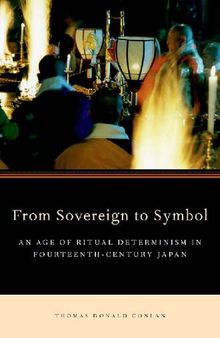دانلود کتاب From Sovereign to Symbol: An Age of Ritual Determinism in Fourteenth Century Japan
by Thomas Donald Conlan|
|
عنوان فارسی: از فرمانروایی تا نماد: عصر جبرگرایی آیینی در ژاپن قرن چهاردهم |
 دانلود کتاب
دانلود کتاب
 جزییات کتاب
جزییات کتاب
Members of the monastic nobility who came to dominate the court used the language of Buddhist ritual, including incantations (mantras), gestures (mudras), and "cosmograms" (mandalas projected onto the geography of Japan) to uphold their bids for power. Sacred places that were ritual centers became the targets of military capture precisely because they were ritual centers. Ritual was not simply symbolic; rather, ritual became the orchestration, or actual dynamic, of power in itself.
This study undermines the conventional wisdom that Zen ideals linked to the samurai were responsible for the manner in which power was conceptualized in medieval Japan, and instead argues that Shingon ritual specialists prolonged the conflict and enforced the new notion that loyal service trumped the merit of those who simply requested compensation for their acts. Ultimately, Shingon mimetic ideals enhanced warrior power and enabled Shogun Ashikaga Yoshimitsu, rather than the reigning emperor, to assert sovereign authority in Japan.









 این کتاب رو مطالعه کردید؟ نظر شما چیست؟
این کتاب رو مطالعه کردید؟ نظر شما چیست؟
